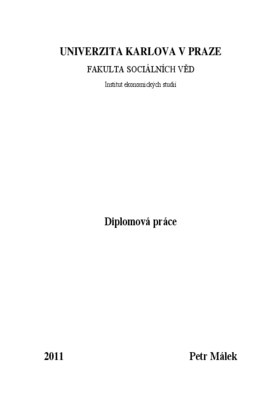Improving Investment Timing
Improving Investment Timing
diploma thesis (DEFENDED)

View/
Permanent link
http://hdl.handle.net/20.500.11956/33807Identifiers
Study Information System: 92607
CU Caralogue: 990013692250106986
Collections
- Kvalifikační práce [19513]
Author
Advisor
Referee
Cingl, Lubomír
Faculty / Institute
Faculty of Social Sciences
Discipline
Economics
Department
Institute of Economic Studies
Date of defense
21. 6. 2011
Publisher
Univerzita Karlova, Fakulta sociálních vědLanguage
English
Grade
Excellent
Keywords (Czech)
finanční trhy, psychologie investování, technická analýzaKeywords (English)
financial markets, psychology of investing, technical analysisTato diplomová práce se zabývá technickou analýzou finančních trhů neboli zkoumáním závislosti mezi aktuálním a minulým vývojem ceny, zejména konceptem "supportů" a "resistencí", tedy cenových hladin, na kterých se cena v minulosti zastavila. Nejprve je uveden výtah z nejdůležitější související literatury na téma technické analýzy, psychologie investování, behaviorálních financí a efektivity trhů. Následují teoretické argumenty ve prospěch možného fungování technických cenových hladin, stejně tak jako odpovědi na předpokládané námitky. Tato teorie je poté v podobě několika tisíc odlišných ale vzájemně podobných obchodních strategií testována na historických cenách několika nejdůležitějších finančních aktiv. Výsledky jsou porovnány s konzervativní buy-and-hold strategií a s náhodným obchodováním. Došli jsme k závěru, že obchodování na základě technických cenových hladin vede k pozitivním výsledkům s výhodou oproti náhodnému obchodování resp. buy-and-hold strategii. Parametry konkrétních strategií naše výsledy častěji ovlivňují očekávaným než neočekávaným způsobem.
This masters thesis is based on study of technical analysis of financial markets, i.e. analysis of dependencies between past and present price data, especially when it comes to "supports" and "resistances" or historical price levels where price recently tended to stop and reverse. First of all, summary of the most relevant literature on technical analysis is presented, together with literature on psychology of investing, behavioral finance and market efficiency. Following that, theoretical arguments in favor of possible edge in trading of technical levels are introduced and possible objections are addressed. This theory - in the form of several thousands of unique but similar trading strategies - is then tested on historical data of the most important financial assets. Results are compared to those of conservative buy-and-hold strategy and random trading. We reached the conclusion that trading based on technical price levels brings positive capital gains which are better than those achieved by random trading and buy-and-hold strategy. Parameters of our strategies influence the results in expectable manner more often than not.
